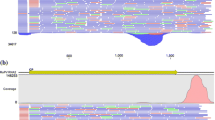Abstract
The complete genome sequence of Kurlavirus, a new member of the family Marseilleviridae is reported. The Kurlavirus genome was found to encode a remarkable complement of genes homologous to those of other members of the family Marseilleviridae. Interestingly, the Kurlavirus genome contains 71 fewer ORFs than that of Marseillevirus, even though their genome sizes are comparable.

Similar content being viewed by others
References
Sharma V, Colson P, Pontarotti P et al (2016) Mimivirus inaugurated in the 21st century the beginning of a reclassification of viruses. Curr Opin Microbiol 31:16–24. doi:10.1016/j.mib.2015.12.010
Raoult D, Forterre P (2008) Redefining viruses: lessons from Mimivirus. Nat Rev Microbiol 6:315–319. doi:10.1038/nrmicro1858
Forterre P, Gaïa M (2016) Giant viruses and the origin of modern eukaryotes. Curr Opin Microbiol 31:44–49. doi:10.1016/j.mib.2016.02.001
Aherfi S, Colson P, La Scola B et al (2016) Giant viruses of amoebas: an update. Front Microbiol 7:349. doi:10.3389/fmicb.2016.00349
Boyer M, Yutin N, Pagnier I et al (2009) Giant Marseillevirus highlights the role of amoebae as a melting pot in emergence of chimeric microorganisms. Proc Natl Acad Sci USA 106:21848–21853. doi:10.1073/pnas.0911354106
Chatterjee A, Ali F, Bange D et al (2016) Isolation and complete genome sequencing of Mimivirus bombay, a Giant Virus in sewage of Mumbai, India. Genomics data 9:1–3. doi:10.1016/j.gdata.2016.05.013
Raoult D, Audic S, Robert C et al (2004) The 1.2-megabase genome sequence of Mimivirus. Science (80) 306:1344–1350. doi:10.1126/science.1101485
Legendre M, Lartigue A, Bertaux L et al (2015) In-depth study of Mollivirus sibericum, a new 30,000-y-old giant virus infecting Acanthamoeba. Proc Natl Acad Sci USA 112:E5327–E5335. doi:10.1073/pnas.15107951121510795112
Chatterjee A, Ali F, Bange D et al (2016) Complete genome sequence of a new megavirus family member isolated from an inland water lake for the first time in India. Genome Announc. doi:10.1128/genomeA.00402-16e00402-16
Besemer J, Lomsadze A, Borodovsky M (2001) GeneMarkS: a self-training method for prediction of gene starts in microbial genomes. implications for finding sequence motifs in regulatory regions. Nucleic Acids Res 29:2607–2618
Altschul SF, Gish W, Miller W et al (1990) Basic local alignment search tool. J Mol Biol 215:403–410. doi:10.1016/S0022-2836(05)80360-2S0022-2836(05)80360-2
Colson P, Pagnier I, Yoosuf N et al (2013) “Marseilleviridae”, a new family of giant viruses infecting amoebae. Arch Virol 158:915–920. doi:10.1007/s00705-012-1537-y
Fabre E, Jeudy S, Santini S et al (2017) Noumeavirus replication relies on a transient remote control of the host nucleus. Nat Commun 8:15087. doi:10.1038/ncomms15087
Thomas V, Bertelli C, Collyn F et al (2011) Lausannevirus, a giant amoebal virus encoding histone doublets. Env Microbiol 13:1454–1466. doi:10.1111/j.1462-2920.2011.02446.x
Doutre G, Philippe N, Abergel C et al (2014) Genome analysis of the first Marseilleviridae representative from australia indicates that most of its genes contribute to virus fitness. J Virol 88:14340–14349. doi:10.1128/JVI.02414-14
Aherfi S, Boughalmi M, Pagnier I et al (2014) Complete genome sequence of Tunisvirus, a new member of the proposed family Marseilleviridae. Arch Virol 159:2349–2358. doi:10.1007/s00705-014-2023-5
Aherfi S, Pagnier I, Fournous G et al (2013) Complete genome sequence of Cannes 8 virus, a new member of the proposed family “Marseilleviridae”. Virus Genes 47:550–555. doi:10.1007/s11262-013-0965-4
Dornas FP, Assis FL, Aherfi S et al (2016) A Brazilian Marseillevirus is the founding member of a lineage in family Marseilleviridae. Viruses 8:76. doi:10.3390/v8030076
Acknowledgements
Research in KK lab is supported by grants from BRNS (2012/37B/26/BRNS/1062), DST (SR/SO/BB-0031/2012) and DBT (BT/PR4808/BRB/10/1029/2012). AC is supported by IIT Bombay Post-Doctoral Fellowship.
Author information
Authors and Affiliations
Corresponding author
Ethics declarations
Conflict of interest
The authors declare that they have no conflict of interest. The article does not contain any studies with human participants or animals performed by any of the authors.
Additional information
The annotated genome was uploaded to NCBI (GenBank ID, KY073338.1).
Electronic supplementary material
Below is the link to the electronic supplementary material.
Rights and permissions
About this article
Cite this article
Chatterjee, A., Kondabagil, K. Complete genome sequence of Kurlavirus, a novel member of the family Marseilleviridae isolated in Mumbai, India. Arch Virol 162, 3243–3245 (2017). https://doi.org/10.1007/s00705-017-3469-z
Received:
Accepted:
Published:
Issue Date:
DOI: https://doi.org/10.1007/s00705-017-3469-z




